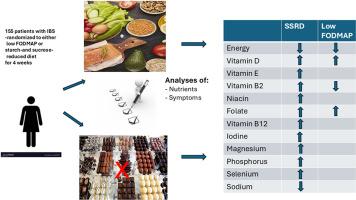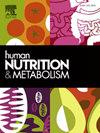A starch- and sucrose-reduced diet leads to a more favorable nutrient profile than low FODMAP in patients with irritable bowel syndrome. A randomized clinical trial
IF 1.8
Q3 ENDOCRINOLOGY & METABOLISM
引用次数: 0
Abstract
A diet low in fermentable oligo-, di-, and monosaccharides and polyols (FODMAP) and a starch- and sucrose-reduced diet (SSRD) both alleviate symptoms in IBS. Our hypothesis was that restrictive diets may preserve good nutritional supply. The aims of the study were to compare nutritional intake between SSRD and low FODMAP, and correlations between changes in nutrient intake, weight, and symptoms. This open, non-inferiority trial included patients with IBS according to Rome IV for a 4-week dietary intervention. Patients completed a 3-day food diary, study questionnaire, Rome IV questionnaire, IBS-severity scoring system (IBS-SSS), and visual analog scale for IBS (VAS-IBS) at baseline, after 4 weeks of either SSRD or low FODMAP, and at a 6-month follow-up. Daily intake of nutrients was calculated. In total, 155 patients (84 % women), 42 (32–55) years, weight 69.2 (63.0–82.9) kg, were included; 77 randomized to SSRD and 78 to low FODMAP diet. After 4 weeks, both SSRD and low FODMAP reduced symptoms, weight, and intake of calories, carbohydrates, sucrose, and monosaccharides, while vitamin D and B12 intake were increased. SSRD uniquely reduced added sugar, disaccharides, starch, and sodium chloride intake, while increasing protein, fat, vitamins, and minerals. In contrast, low FODMAP reduced intakes in fiber and several vitamins and minerals after 4 weeks and follow-up. The reductions of galacto-oligosaccharides and fructan were most pronounced in SSRD (p < 0.001). These findings highlight the SSRD's potential for broader health benefits and a more nutritionally balanced approach with higher nutrient density compared to the low FODMAP diet.

在肠易激综合征患者中,淀粉和蔗糖减少的饮食比低FODMAP更有利于营养状况。一项随机临床试验
低发酵寡糖、二糖、单糖和多元醇(FODMAP)的饮食和淀粉和蔗糖还原饮食(SSRD)都能减轻肠易激综合征的症状。我们的假设是限制性饮食可以保持良好的营养供应。本研究的目的是比较SSRD和低FODMAP患者的营养摄入量,以及营养摄入量、体重和症状变化之间的相关性。这项开放的非劣效性试验纳入了根据Rome IV标准的IBS患者,进行为期4周的饮食干预。患者在基线、SSRD或低FODMAP治疗4周后和6个月随访时完成了为期3天的食物日记、研究问卷、Rome IV问卷、IBS严重程度评分系统(IBS- sss)和IBS视觉模拟量表(VAS-IBS)。计算每日营养素摄入量。共纳入155例患者(84%为女性),42(32-55)岁,体重69.2 (63.0-82.9)kg;77人随机选择SSRD组,78人随机选择低FODMAP组。4周后,SSRD和低FODMAP均减轻了症状、体重,减少了卡路里、碳水化合物、蔗糖和单糖的摄入量,同时维生素D和B12的摄入量增加。SSRD独特地减少了添加糖、双糖、淀粉和氯化钠的摄入量,同时增加了蛋白质、脂肪、维生素和矿物质。相比之下,低FODMAP在4周和随访后减少了纤维和几种维生素和矿物质的摄入量。半乳糖低聚糖和果聚糖的减少在SSRD中最为明显(p <;0.001)。这些发现强调了SSRD具有更广泛的健康益处的潜力,与低FODMAP饮食相比,SSRD具有更高的营养密度和更营养均衡的方法。
本文章由计算机程序翻译,如有差异,请以英文原文为准。
求助全文
约1分钟内获得全文
求助全文
来源期刊

Human Nutrition and Metabolism
Agricultural and Biological Sciences-Food Science
CiteScore
1.50
自引率
0.00%
发文量
30
审稿时长
188 days
 求助内容:
求助内容: 应助结果提醒方式:
应助结果提醒方式:


